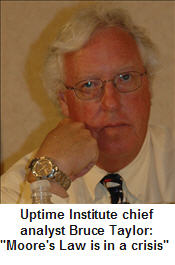Holistically (including economics and environment), Moore's Law could be failing


According to Taylor who gave a 50,000 foot overview:
There's an economic meltdown of Moore's Law...it depends on the industry, customer, datacenter (the refresh rate of the gear in those datacenters). The general principle is that there's an ever widening gap between computational performance at the processor/server level that's not being met by a corresponding power consumption change.. Datacenters and business are running out of power cooling, and square footage. IT departments didn't have a sufficient warning that this was coming. They didn't have time to plan adequately or optimally...The result is sub-optimal data centers doing retrofits in (quick fixes) which ultimately don't work...So we're in a crisis now. Moore's Law is alive and well in the server and chip, but not doing well at an overall system level....
...Now, it's a major economic and environmental issue.....IT will be the second largest industrial user of power (to heavy manufacturers) in the country. By 2012, 15 percent of the total IT budget will be in the facilities to manage it. It's a major environmental concern (most of the power comes from carbon fuels so the carbon footprint is very large) and it's a major economic concern and an overall sustainability issue.
Taylor went on to say compare IT oversight to the purchase of an SUV. He said that if the cost of the SUV included the cost of its fuel, it would change our thoughts about buying SUVs. Taylor posits that the same rules should apply to datacenters.
I'll continue to add to this blog as the panelists offer their insights.
Back to the future? EMC's Dick Sullivan points out how, when a local highway in the Boston area that recently celebrated its 50th anniversary was opened, a railway in the area was shut down. That highway is so congested now that a railway is being brought back. Looking at the SUV analogy, Sullivan posits that it's not just the cost of the SUV and its fuel that one needs to consider, but the infrastructure is well and that we may find ourselves going "back to the future" when it comes to certain infrastructure approaches. A member of the audience chimed in that tape (as in tape storage) may end up being the equivalent of that railway being brought back.
Does everyone need information at their fingertips? APC's John Tucillo asks if, just because certain regulations require retention of data for seven years, does that mean that the compliance people need the same real-time access to that information as the real-time access that traders on the floor have. The conversation is now on a meme regarding the amount of servers that are actually mission critical. The solutions being discussed are not just about server consolidation through techniques such as virtualization, but also complete server shutdown where the criticality of the application isn't nearly as mission critical as thought to be.
Server accoutrements require more power than the processors themselves? It's an issue that AMD Opteron product marketing manager Brent Kerby says AMD is looking into. Other system components (for example fans and other gear for keeping the systems cool) are taking more power than the processors themselves, driving overall consumption up.
Datacenter layouts? Taylor says that the average datacenter uses three times the amount of cooling than it actually needs because it's laid out with aesthetics in mind, rather than energy efficiency. EMC's senior marketing manager Dick Sullivan comments that this is an issue of best practices that most people simply aren't aware of. He posits that datacenter managers may not be proactive enough in realizing that knowing these best practices are a part of their jobs. CNET News.com's ace reporter Martin Lamonica (sitting next me) asks if it isn't more an issue of not understanding the payback. If datacenter managers aren't clear on what the potential paybacks are, then why would they spend time trying to learn these so-called best practices. Good question. What makes a best practice best? APC's John Tucillo eventually points out the issue of "close-coupled cooling" and the amount of power that's wasted when the sources of cooling aren't close enough to the gear being kept cool.
A good zinger from IDC's storage systems vp Rick Villars who asks if part of the problem isn't the sales person for EMC (or HP) who is looking to close the next sale, driving more gear into the datacenters and simply propogating the problem. HP blade system infrastruture technologist Ken Baker fired back that his company works more closely with customers before simply dropping a new SuperDome server in their datacenters.
Are datacenters too cold? HP's Baker points out that most datacenters are kept at around 60 degrees which is much colder than those datacenters need to be given the specs to which servers are built (he claims 68 to 72 degrees is more appropriate). But on the flipside, he acknowledges that many datacenter managers see the 60 degree level as buying them some time in the event that there's some failure that knocks the cooling facilities out (rather than living on the edge where, if the cooling fails, system failure or shutdown isn't much further behind).